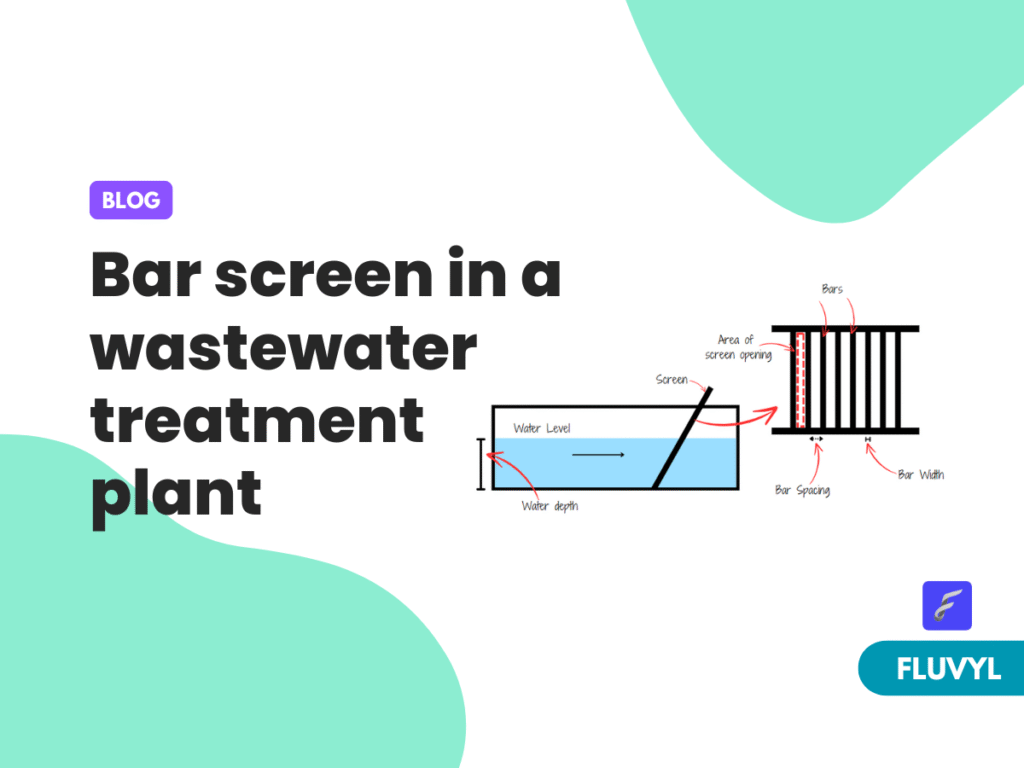Explain the Function of Bar Screen in a Wastewater Treatment Plant

By Fluvyl, updated Apr 18, 2025

Synopsis
Wastewater treatment is a complex and essential process that involves several stages to ensure that contaminated water from domestic, industrial, and commercial sources is cleaned before being released back into the environment. One of the first and most crucial components of a wastewater treatment plant (WWTP) is the bar screen. Despite its seemingly simple structure, the bar screen plays a vital role in protecting downstream equipment, improving treatment efficiency, and maintaining smooth plant operation.
In this blog post, we’ll take a deep dive into understanding the function of bar screens, their types, design considerations, operational principles, and advantages, supported by illustrations, examples, and industry insights.
What is a Bar Screen?
A bar screen is a mechanical filter or grid of parallel bars placed at the entrance of a wastewater treatment plant or in the influent channel of a treatment unit. Its primary role is to remove large solid objects such as:
- Rags
- Sticks
- Plastics
- Leaves
- Stones
- Large food particles
- Other debris
These objects, if not removed, could damage or clog pumps, valves, pipelines, aerators, or other sensitive treatment equipment.
Function of a Bar Screen in a Wastewater Treatment Plant
1. Initial Stage of Treatment (Preliminary Treatment)
Bar screens are part of the preliminary treatment stage of a WWTP. This stage is responsible for removing large particles and materials that can hinder or damage downstream processes.
Function:
The bar screen intercepts and collects coarse solids from incoming wastewater, preventing them from entering the main treatment stages (primary, secondary, and tertiary).
2. Protection of Downstream Equipment
Bar screens protect critical infrastructure like:
- Pumps
- Aerators
- Pipelines
- Sludge handling equipment
- Grit chambers
Function:
By removing large solids, the bar screen reduces wear and tear on mechanical equipment, preventing blockages and minimizing maintenance costs.
3. Improved Efficiency of Treatment
Large solids in wastewater can interfere with the performance of biological and chemical processes by:
- Reducing contact surface area for microbes
- Blocking oxygen flow in aeration tanks
- Affecting chemical dosing efficiency
Function:
By eliminating unwanted coarse materials, the bar screen ensures that subsequent treatment stages are more effective and efficient.
4. Odor and Aesthetic Control
Accumulation of large organic matter like food waste, leaves, and tissues in untreated wastewater can lead to rapid decomposition and unpleasant odors.
Function:
Bar screens help reduce odor generation by quickly removing organic debris before it starts decomposing.
5. Reduction in Sludge Volume
Solid waste that passes through to the later stages often ends up in sludge, requiring more energy and cost to treat or dispose.
Function:
Bar screens limit the load on sludge handling units by capturing large debris early in the process.

Download This personal Guide E-book
Types of Bar Screens
Bar screens can be manually cleaned or mechanically cleaned, depending on plant size, inflow rate, and labor availability.
1. Manual Bar Screen
- Simpler design
- Low capital cost
- Requires manual labor to rake and remove collected debris
- Suitable for small-scale plants or emergency use
Limitation:
Labor-intensive and less efficient, especially in high-flow conditions.
2. Mechanically Cleaned Bar Screen
- Automated cleaning using rakes, chains, or brushes
- Designed for medium to large treatment plants
- Reduces human intervention
- Can operate continuously or at preset intervals
Examples:
- Chain-driven rake screens
- Traveling band screens
- Rotary drum screens
- Step screens
3. Fine and Coarse Bar Screens
Bar screens are often categorized by the spacing between bars:
- Coarse Bar Screen: >25 mm spacing
Removes large debris like branches and bottles. - Fine Bar Screen: 6–25 mm spacing
Captures smaller solids and improves downstream protection.
Bar Screen Components and Construction
Typical bar screen system includes:
- Bar Rack: Vertical or inclined metal bars made of stainless steel or mild steel.
- Frame Structure: Supports the bar rack.
- Raking Mechanism: Mechanical or manual system to clean the screen.
- Disposal System: Conveyors or bins to collect and transport screenings.
- Control Panel: For automated screen operation (in mechanical systems).
Material Used
- Stainless Steel (SS 304 or 316): High corrosion resistance.
- Mild Steel with Coating: Economical but requires maintenance.
Design Considerations for Bar Screens
Designing an effective bar screen system involves several parameters:
| Parameter | Design Guidelines |
|---|---|
| Bar spacing | 6–100 mm depending on fine or coarse screening |
| Bar inclination | 30°–75° from the horizontal |
| Approach velocity | 0.6–1.2 m/s (to prevent settling or pass-through) |
| Maximum head loss | Typically 150 mm |
| Channel width | Should accommodate screen and raking mechanism |
| Flow rate | Must be matched to plant’s peak capacity |
Head Loss Across Screen
Bar screens create a hydraulic head loss that must be calculated to ensure proper flow dynamics. The head loss depends on:
- Flow rate
- Bar spacing
- Velocity
- Screen clogging
Empirical Formula (Kirschmer’s Equation):
![]()
Where:
- h = Head loss
- K = Coefficient (depends on bar shape and spacing)
- V= Approach velocity
- g = Gravitational acceleration
Operation and Maintenance
Regular maintenance ensures consistent performance. Key tasks include:
Manual Screen Maintenance
- Regular raking and removal of debris
- Washing and disinfection of screenings
- Periodic inspection for corrosion or damage
Mechanical Screen Maintenance
- Motor and chain lubrication
- Sensor checks for automatic controls
- Debris conveyor maintenance
- Emergency manual operation readiness
Safety Tip: Workers handling screenings should wear PPE due to potential pathogens.
Advantages of Bar Screens
| Benefit | Description |
|---|---|
| Equipment protection | Prevents clogging and damage to pumps and pipelines |
| Operational efficiency | Enhances downstream process efficiency |
| Cost-effective | Reduces maintenance and energy use in later stages |
| Simple and scalable | Can be customized for all plant sizes |
| Reduced sludge load | Less solid waste reaching sludge processing units |
| Improved plant lifespan | Protects key equipment and reduces repair frequency |
Challenges and Limitations
Despite their benefits, bar screens may present certain challenges:
| Challenge | Mitigation |
|---|---|
| Frequent clogging | Use of automatic cleaning systems or multiple screens |
| Odor from collected debris | Timely removal and deodorizing agents |
| High maintenance for manual units | Upgrade to mechanical units in larger plants |
| Space requirement | Use vertical or compact designs in small plants |
Bar Screens vs. Other Preliminary Devices
| Feature | Bar Screen | Grinder/Comminutor | Screening Drum/Rotary Screen |
|---|---|---|---|
| Purpose | Coarse solid removal | Grind solids to smaller size | Capture fine particles |
| Operation | Manual or mechanical | Mechanical only | Mechanical with mesh |
| Cost | Low to moderate | Moderate | High |
| Maintenance | Moderate | High (due to blades) | High |
Conclusion
The bar screen may appear to be a humble piece of equipment, but it is undeniably one of the most essential components of a wastewater treatment plant. From protecting expensive machinery to improving process efficiency and reducing operational burdens, its contributions are invaluable.
In an era where sustainable water management is critical, investing in proper bar screen design, automation, and maintenance is not just a technical requirement—it’s an environmental and economic necessity.
Whether you’re planning a new treatment facility or upgrading an existing one, don’t overlook the power of a well-functioning bar screen. It’s the plant’s first line of defense—and its most reliable guardian.
